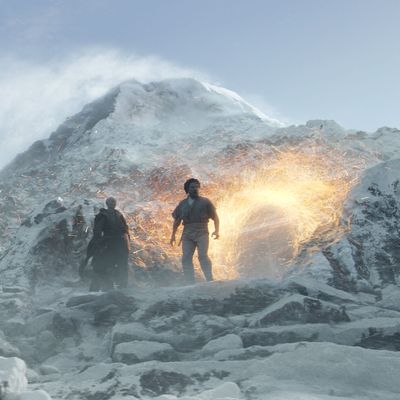
Spoilers below for Doctor Strange (and a few other movies).
Although Doctor Strange, the latest bajillion-dollar Marvel movie to be thrust upon a willing public, might look like something Timothy Leary entertained in the pinball-lit recesses of his LSD-addled brain, it still shares plenty of DNA with its blockbuster brethren. Sarcastic, hypercompetent protagonist who undergoes a board-certified Hero’s Journey? Check. Conveyor-belt villain who exists mostly as a plot mechanism? Check. Cursory nods to its cinematic universe, which hovers over the proceeds like a 120-minute wink? Check, check, check. But as much as Doctor Strange might be on trend overall, it also shares one odd, very specific trope with a number of other films to come out this year. I’m talking, of course, about inter-dimensional portals.
Inter-dimensional portals, you say? That seems like a weird thing to keep showing up across different and unrelated films. In the case of Doctor Strange, the portal functions as the gateway between our world and the Dark Dimension, from which an evil force called Dormammu will emerge to consume humanity, or something. Regardless of your interest in Dormammu, the letter M, and universes that look like insets in a science textbook, the portal isn’t really about that: It’s more important for allowing Strange to do some nifty dimension-hopping and time-manipulating, the movie’s bread and butter.
But while the portals of Doctor Strange may enable some of its most engaging and unique visuals, they’re far from an original conceit. You can trace the recent spate of portals back to the first Avengers in 2012, when Loki, using the Tesseract — itself part of another irritating trend of glowing MacGuffins — opened a portal over New York City, allowing for the entry of countless flying aliens into our vulnerable universe. But if Avengers marked the start of this trend, 2016 represents its apex, and Doctor Strange is the third movie this year to feature an inter-dimensional portal through which emerge hordes of widget-like enemies. Teenage Mutant Ninja Turtles: Out of the Shadows got there first, with big-bad Krang also opening a portal over poor New York; next was Ghostbusters, which managed to echo not only these recent examples but its own 1984 predecessor by opening a portal, again in New York. (It should be noted that the original Ghostbusters represents both an early and particularly well-done version of this trope; the OG Ghostbusters portal is weirder, funnier, and more gleefully overwrought than any in recent vintage.)
There are a few obvious reasons why these portals seem to be so in vogue. By sewing in hordes of portal-hopping baddies, the filmmakers give their heroes an easily accessible and narratively clear-cut obstacle, whose mere existence seems to pose a threat to our own world — saving the trouble of having to locate their armies of evildoers in the complicated geopolitics of an actual Earth. Second, they facilitate another common aspect of recent plots: the lackey who wants to bring about the destruction of the world. Shredder in TMNT, Neil Casey’s Rowan North in Ghostbusters, and Mads Mikkelsen’s Kaecilius put a human face on the otherwise inhuman enemy; without them, the struggle would feel too cosmic and alienated from the protagonists, who usually feel something personal about the lackeys and their intentions.
Most of all, though, these portals represent a quagmire. Because of the scale and scope of the modern blockbuster, a climactic final battle is required, even in a movie that shouldn’t seem to call for such a set piece, like the comedy of Ghostbusters, or one that yearns for a more original conclusion, à la Strange. The portal, then, provides a catalyst, an easy door through which the movie can step into its denouement with maximum destruction. As long as the portal is open, the movie continues; once it is shut, the movie can end. These portals are a metaphor for the movies themselves, self-perpetuating catch-22’s that have no reason to exist other than their own existence, and their success or failure works as a direct reflection of what the movies do with this notion. Doctor Strange played with house money and delivered one of the most visually adventurous studio films in recent memory; TMNT and Ghostbusters played it safe and failed to resonate with the public at large.
Still, there are other ways, even within the studio-blockbuster framework, of delivering an audience to an ending — and the more dimensions that unfold from the insides of these films, the more they all start to seem exactly the same. If Doctor Strange is right, and the multiverse contains an infinite number of different worlds, let’s explore one or two of them that don’t involve holes in the sky.




